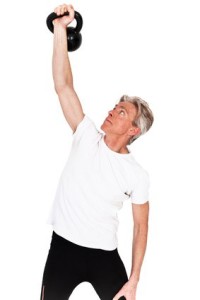How Much Protein Do We Need?
Author: Dr. Stephen Chaney
 What are the protein needs for older adults? In previous “Health Tips From the Professor” I have covered the optimal amount of protein for weight loss diets in high protein diets and weight loss and following workouts . In this issue of “Health Tips From the Professor” I will review the latest information about protein needs as we age.
What are the protein needs for older adults? In previous “Health Tips From the Professor” I have covered the optimal amount of protein for weight loss diets in high protein diets and weight loss and following workouts . In this issue of “Health Tips From the Professor” I will review the latest information about protein needs as we age.
To put this in perspective, many Americans suffer from sarcopenia (loss of muscle mass) as they age.
Some of you may be saying “So what? I wasn’t planning on being a champion weight lifter in my golden years.” The “So what” is that loss of muscle mass leads to loss of mobility, a tendency to fall (which often leads to debilitating bone fractures) and a lower metabolic rate – which leads to obesity and all of the illnesses that go along with obesity.
How Can We Prevent Loss of Muscle Mass As We Age?
Fortunately, sarcopenia is not an inevitable consequence of aging. There are things that we can do to prevent it. The most important thing that we can do to prevent muscle loss as we age is to exercise – and I’m talking about resistance (weight) training, not just aerobic exercise.
But we also need to look at our protein intake and our leucine intake. Protein is important because our muscle fibers are made of protein.
Leucine is an essential amino acid. It is important because it stimulates the muscle’s ability to make new protein. Leucine and insulin act synergistically to stimulate muscle protein synthesis after exercise. I have covered the evidence behind leucine’s importance in maintaining and building muscle mass in a previous “Health Tips From the Professor”, Leucine Triggers Muscle Mass.
Do Our Protein Needs Increase As We Age?
 Interestingly, our protein needs actually increase as we age. Campbell et al (Journal of Gerontolgy: Medical Sciences 56A: M373-M380, 2001) showed several years ago that RDA levels of protein were not sufficient to maintain muscle mass in both men & women aged 55 to 77 years old.
Interestingly, our protein needs actually increase as we age. Campbell et al (Journal of Gerontolgy: Medical Sciences 56A: M373-M380, 2001) showed several years ago that RDA levels of protein were not sufficient to maintain muscle mass in both men & women aged 55 to 77 years old.
Many experts recommend that those of us in our golden years should consume the amount of protein in grams that is equivalent to half our body weight in pounds every day.
When Should We Eat Our Protein?
When we consume the protein is also important. Forget that continental breakfast, salad for lunch and protein-rich dinner. As we age we increasingly need high quality protein at every meal.
In one study, young adults (average age = 31), experienced increased muscle protein synthesis when they consumed as little as 15 grams of protein at a meal, but older adults (average age = 68) experienced no increase in muscle protein synthesis in response to the same low protein meal (Katsanos et al, Am J Clin Nutr 82: 1065-1073).
However, when the amount of protein in a meal was increased to 30 grams (equivalent to a 4 oz piece of chicken or beef) both younger and older adults were able to use that protein to build muscle (Symons et al,Am J Clin Nutr 86: 451-456, 2007).
But, 30 grams seems to be about optimal. Protein intakes above 30 grams in a single meal resulted in no further increase in muscle protein synthesis (Symons et al, J Am Diet Assoc 109: 1582-1586, 2009), which means you can’t hope to get all of the muscle building benefits of protein in a single meal.
As a consequence of these studies most experts recommend that we “golden agers” aim for 20 to 30 grams of high quality protein with every meal.
How Much Leucine Do We Need?
 The story with leucine is similar. 1.7 grams of leucine was not sufficient to increase muscle protein synthesis following exercise in older adults, while 2.7 grams was sufficient (Katsanos et al, Am J Physiol Endocrinol Metab 291: E381-E387, 2006). So the experts recommend that older adults get 3 grams of leucine in our diet following workouts to maximize the effect of the workout.
The story with leucine is similar. 1.7 grams of leucine was not sufficient to increase muscle protein synthesis following exercise in older adults, while 2.7 grams was sufficient (Katsanos et al, Am J Physiol Endocrinol Metab 291: E381-E387, 2006). So the experts recommend that older adults get 3 grams of leucine in our diet following workouts to maximize the effect of the workout.
And, of course, if we want to maximize the effects of resistance training, both the protein and leucine need to be consumed after we exercise, not before (Fujita et al, J Appl Physiol 106: 1730-1736, 2009).
Where Do We Get the Protein and Leucine We Need?
So, where do we get the amount of protein and leucine that we are looking for?
If you want to get them from food alone, 4 oz servings of meat are a good starting place – with chicken being the best (35 grams of protein and 2.7 grams of leucine). Dairy, eggs and vegetable foods are much lower in leucine, protein or both.
Unfortunately, I keep running into seniors who are fully convinced that broccoli and tofu will meet their protein needs. I fully understand the rationale for choosing vegetarian protein sources, but you need a bit more than broccoli and tofu if you are going to meet your protein needs in your golden years.
For example, a 4 ounce serving of tofu provides only 10 grams of protein and 0.8 grams of leucine, and a 1.5 cup serving of broccoli provides only 4.2 grams of protein and a miserly 0.36 grams of leucine. That makes it very difficult to meet your target of 20-30 grams of protein and around 2.7 grams of leucine with each meal.
I’m not saying that you can’t get enough protein and leucine to maintain muscle mass on a vegetarian diet. However, you will need to plan that diet very carefully.
So, if you want to know what the old professor does, here it is:
I work out almost every day. On the days when I work out in the morning I rely on a protein shake immediately after the workout to meet my protein and leucine goals. On the days when I train at the gym in the late afternoon, I rely on 4 oz of chicken or fish with dinner to meet those goals.
Those of you who know me know that I will never be featured in muscle magazine, but at least I’m gaining muscle mass – not losing it.
The Bottom Line
- As we age many Americans suffer from sarcopenia (loss of muscle mass). The loss of muscle mass leads to loss of mobility, a tendency to fall (and break things) and a lower metabolic rate – which leads to obesity and all of the illnesses that go along with obesity.
- The most important thing that we can do to prevent muscle loss as we age is to exercise – especially resistance (weight) training exercise – at least 30 minutes every day. It is also important to make sure that we are getting adequate intake of protein and the essential amino acid leucine.
- Our protein needs increase as we age. Recent studies suggest that the RDA levels of protein are not sufficient to maintain muscle mass in people over the age of 55. Many experts recommend that those of us in our golden years consume the amount of protein in grams that is equivalent to half our body weight in pounds every day.
- Recent studies show that it is important to spread that protein out through the day rather than consume one protein rich meal at the end of the day. If we are over 50 we should be aiming at 20-30 grams of protein per meal. However, more than 30 grams of protein at a single serving appears to provide no additional benefit.
- Seniors also appear to need more leucine in each meal than younger adults if they wish to preserve muscle mass. Young adults need only around 1.7 grams of leucine per serving to stimulate muscle protein synthesis, while mature adults may need as much as 2.7 grams per serving.
- Well-designed protein shakes and 4 ounces of lean meats are the easiest way for seniors to meet their protein and leucine needs. Vegetarian diets can provide the protein and leucine needed to maintain muscle mass in seniors, but those diets need to be very well planned. Broccoli and tofu just don’t make the grade if you are serious about preserving muscle mass.
These statements have not been evaluated by the Food and Drug Administration. This information is not intended to diagnose, treat, cure or prevent any disease.
